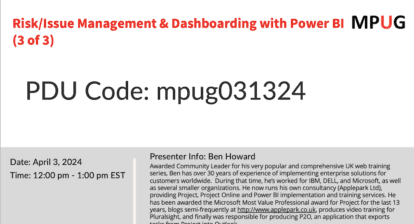
There is a lot in your project environment that you cannot control, no matter how hard you try! However, you can control your own perspective and boost your productivity by adopting a time maximizer mindset. If you’ve not heard of a time maximizer mindset before, it is where you focus on what you can do today to make things better, faster, or easier tomorrow. Think about how you can maximize your time so you get more done in the hours available.
It’s simple to start maximizing your time. Every time you start a task, think about whether you’ll be doing it, or something like it, again. Then consider what you could do so that it takes less time in the future. As project managers, a lot of our work does have repetitive elements, so there is plenty we can do to streamline how tasks are done.
Putting a little bit more effort into doing today’s tasks will make future tasks a lot easier. Let’s look at eight ways to make life easier for Future You.
- Document a Process
Document or create a process so you can repeat the work easily next time. That might mean writing a standard operating procedure, a checklist, or simply notes for yourself that you store in a place you can easily locate. The goal is to reduce the mental overhead of having to think through the process each time. You can update the document with tips and extra steps as you use it, so don’t worry about it being perfect first time.
Encourage your colleagues to do the same so you build up a library of how to do routine tasks like extracting data for monthly reporting or arranging an end-of-sprint demo. Then when you’re back from a fortnight in the sun, you won’t struggle remembering all the steps. - Train a Colleague
If you find that work piles up when you’re not around to do it, you might find that training a colleague helps spread the load. Training does take time, but remember you’ll get that time back when a peer is confident in taking on the task – and it won’t be waiting for you. Write comprehensive training materials and test them out. Keep adding in frequently asked questions and notes to reduce reliance on you and to share your knowledge. Put any training notes in the same location as your process documents and checklists so the team has access to a growing knowledge repository. If you can, delegate the task permanently so you don’t have to do it again. - Create a Template
We all use document templates for standard reports and presentations, but do you have templates set up for brand colors and fonts in your slide decks, for example? Or custom palettes in your graphics tools? Write template text for emails you send often or questions you get asked a lot. Create a bank of cut-and-paste responses to save time typing them, and set up auto-text in your word processing tool to automatically type them out for you. For example, typing “weekly report email” could insert the greeting, introductory sentences, structure of the report, and your closing sign off. Then all you have to do is insert the progress from the week. - Set up an Automation
Make the most of workflow tools you have by creating automations for approvals and processes. Automations push work through a standard process without you having to move it along manually. That can save time when requesting approvals for documents or changes as you don’t need a human to respond to an email and send the document on to the next process step. Small automations are useful too. For example, a text expander function will insert your whole office address if you type the building number, or the name of a supplier if you type the initials. This will save you from looking it up (again) to check the correct spelling. - Learn Shortcuts
Need to do something in a spreadsheet? Learn the formula or shortcut to speed up how you do the work. If you don’t think you’ll use the function very often, write it down in a ‘shortcuts log’ so you can quickly refer back to it next time you have to complete the same action. Learn how to use your tools and integrate them with the apps you might already have. For example, there are many extensions for browsers and collaboration tools that allow you send tasks to your project management software, create meetings or run workflows. Start your own personal library of your favorites. - Rename Files
Been sent a file called “Minutes.docx”? Rename it to make it easier to find in the future before saving it in the location it should be (and not leaving it in your inbox or ‘Documents’ folder). If you put a date in the filename, try using the convention year-month-date like 20240501 for May 1, 2024. Put the date at the start of the filename, followed by a descriptive name. Sort your files alphabetically and you’ll find that they sort in chronological order. - Create a Master Action List
Consolidate all your action logs or To Do lists into one master list or tool. Transfer all your sticky notes and handwritten reminders into the same task management app so you’ve got one single version of your priorities.
Put some time in your diary each week for an action log review and catch up. Use the time to make sure any new notes are copied into the master action log. You’ll find it much easier to understand your work overall and prioritize your tasks. - Schedule Regular Reflection Time
Put time aside to reflect on what has been working for you (and what hasn’t). It doesn’t need to be long but it does need to be mindful. Pop 15 minutes in your calendar every couple of weeks to switch off from the distractions of the office and think about what active steps you can take to do more of what works. Equally, consider what you can stop doing that is not adding value. You might be able to remove certain activities completely, or you might want to change up what you are doing to make it more effective.
Set yourself up for future success
The time maximizer mindset is about making sure the work you are doing today is setting you up for future success – or at least not undermining your success by making things harder for your future self. Yes, it requires an investment of time today – normally a small amount. But you get the satisfaction of knowing that investment will pay off in the future. Be prepared for it to be hard, especially when you’re up against a deadline. Carving out the time in the short term to create an environment for longer term productivity and success has been a mindset shift for me! The more you consciously reflect on whether you are maximizing your time for the long term, the easier you will find it.
Related Content
8 Tips for Better Time Management: Project Manager Edition
Time Management Strategies for a Chaotic World
Lesson: Must-Know Excel Functions to Increase Your Productivity
Elevate your project management skills and propel your career forward with an MPUG Membership. Gain access to 500+ hours of PMI-accredited training, live events, and a vibrant online community. Watch a free lesson and see how MPUG can teach you to Master Projects for Unlimited Growth. JOIN NOW







